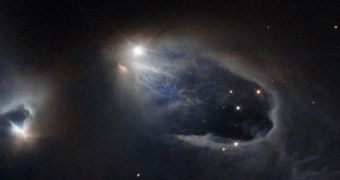Mission controllers in charge of the Hubble Space Telescope have just released a new image of an interesting collection of Herbig-Haro objects, which are intermediate-mass stars that have not yet fully formed or reached their main sequence. It is very common for these objects to sneeze large volumes of gas, which is exactly what this image shows.
The object to pay attention to in particular is located at the center of the image above. The star is releasing very large, very fast, and very hot blobs of gas, which appear to be standing still from our vantage point. However, observing this location once every few centuries will undoubtedly reveal how this gas is moving away from the HH object.
The center stage of this image is occupied by the variable star V633 Cassiopeiae, which was recently observed by Hubble. The NASA/ESA telescope revealed that the gas clouds released by the star were traveling at speeds of several hundreds of kilometers per second, forming shock waves as they move through the surrounding gas.
Over the next century or so, the star is expected to fully mature and reach its main sequence. During this stage in its life, it will burn hydrogen steadily and will begin its stellar cycle. Coincidentally, this particular HH object will form a star the size of the Sun, meaning that its main sequence will probably last for around 10 billion years.

 14 DAY TRIAL //
14 DAY TRIAL //